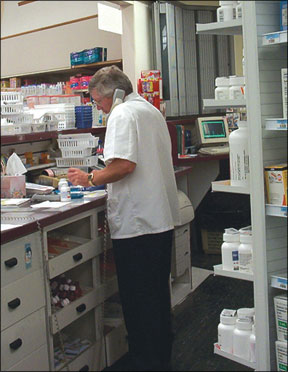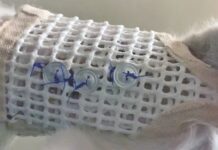Some cats are model patients. They sit calmly for nail trims and they let you look inside their mouths and even brush their teeth, purring all the while. Other cats – perhaps the majority – are not so accommodating. You just think about trimming their nails and they disappear. Getting a pill into them requires protective gear Bev Caldwell 288 and strong determination. Drew Weigner, DVM, a board-certified member of the American Board of Veterinary Practitioners and founder of The Cat Doctor in Atlanta, Georgia, knows all about pill resistance. “There are a lot of different ways of getting medications into cats,” he says. Hes found that many cats will accept crushed pills – provided they arent bitter-tasting – if theyre mixed into a tiny amount of tasty food, such as canned tuna, peanut butter or liverwurst. But the desperate owners of hard-core pill haters know that its not always that simple. Its frustrating being unable to give needed medication, but even worse is the negative association it creates in the animal. The best owners are the ones who love their cats deeply and are determined to preserve their health. They are also the most distressed when this love makes them the enemy as far as their cats are concerned. More and more veterinarians and pet owners are turning to custom-made compounded medications as a welcome solution. But you need to use them wisely. What are Compounded Medications? Compounding pharmacies put drugs into forms not commercially available, in doses appropriate for individual patients. But long before the word “pharmacy” came into existence, indigenous peoples were creating remedies from various materials in their environment, usually plants. Combining different agents, or “compounding,” was considered an art form and was practiced only by village shamans or priests. Modern pharmacists deal with complex pharmaceutical remedies far different from the elixirs, spirits and powders described centuries ago, but the biggest change has been the virtual disappearance of compounded medicines. In the 1920s, the majority of prescriptions filled in American pharmacies required an understanding of compounding. Then technological advances begged the question: “Why make something by hand when it can be mass produced by machines?” By the 1940s, less than a third of all prescriptions required compounding. Today, pharmaceutical history has come full circle, and custom compounding is coming back in popularity. In fact, it accounts for many of the prescriptions shipped to clients across the country by the registered pharmacists at the Cornell University Hospital for Animals. Physicians, patients, veterinarians and pet owners are recognizing once again the importance of tailoring medications to individual needs. A Spoonful of Sugar The active ingredients in compounded preparations can be put into a wide variety of forms: transdermal patches, creams, ointments and gels for topical administration; nasal and oral sprays; otic insufflations (preparations designed to be blown into the ear); suppositories and more. Giving Fluffy her medication in a bacon-flavored liquid or a tuna-flavored chewable tablet can turn “trial” into “treat” – but it might take some experimenting to find the right preparation. Pet owners love compounded medications because they are convenient, but Dr. Weigner has other reasons for using them. “Its primarily a medical issue, rather than a client compliance issue,” he says, citing three situations in which he prefers compounded medications. Customized Treatment You Can Count On While all pharmacists are trained in compounding, few of them now do it routinely, and even fewer do it for the veterinary market. Its important that a pharmacist be familiar with the specifics of formulating preparations for animals. Like many practitioners, Dr. Weigner uses a local pharmacy that has experience and expertise in compounding veterinary medications and is a trustworthy supplier. He knows that when clients are treating a pet with a long-term illness, its vital that a medication source be reliable. If a pharmacy moves or goes out of business, a veterinarian can be left scrambling to find a substitute. Its also extremely important that the product remain consistent. If a pharmacy suddenly stops carrying a certain product or it changes to a different flavor, an owner might find her cat refusing to take the new formula. Some veterinary colleges – such as Cornell Universitys – have registered pharmacists who specialize, or are board-certified, in veterinary pharmacology and who offer compounded drugs to veterinarians all over the country. And in recognition of the growing need for veterinary compounding, national compounding pharmacies are springing up, to the delight of some veterinarians. National pharmacies can sometimes provide a wider range of products than smaller, local pharmacies, and some ship directly to the client as well. Of course, pet owners still have to go through their veterinarians in order to obtain the products. Quality Control The U.S. Food and Drug Administration puts all drugs through a stringent and costly testing process before giving them the stamp of approval. Because pre-approval drug studies are performed on a very specific formula and dosage, even relatively small compounding changes can convert an approved drug (a product tested as a pill, for example) into an unapproved one (such as a liquid form made by the pharmacist). “Compounding is good and bad,” says Dr. Weigner. “Part of the problem with compounded medications is that no one has ever measured their stability or documented their absorption and bioavailability.” As unapproved drugs manufactured without FDA oversight, compounded medications involve an extra risk factor compared to approved ones. “None of this is to say that were against compounding medications,” adds Dr. Weigner. “We use them. You just have to think about the issues. Is it okay to take a pill, crush it up, mix it with something and spread it on your skin? Maybe.” And maybe not. Use Common Sense: Follow Instructions Consumers cant control pharmaceutical regulations, but they can control how they use a product. Heres where compliance is essential, stresses Dr. Weigner. “Buy in small quantities to reduce the issue of stability. Measure carefully. Store liquids in the refrigerator and mix them very, very well, because they will settle out,” he emphasizes. When medications are produced commercially, the manufacturing process ensures a high level of quality control. When custom-compounded medications are made by individual pharmacists, human error becomes a natural factor. “Look at the label every time you get a refill,” Dr. Weigner says. “Does it match whats on the prescription?” Preserving the Bond In the past, when a beloved cat resisted treatment, the choices were limited: Force the issue and build resentment, or dont force it and watch the cats health deteriorate. Thoughtful, appropriate use of customized medication through compounding can help preserve the animals health, without compromising the owner-pet relationship. 

Compounding May Help Your Medication Woes
When your cat is sick, it's important to be able to administer medicine. Here's help.
When prescribing dose-critical medications: “When its essential that the cat get the entire dose, exactly as prescribed, giving partial pills or liquids might not be reliable enough,” says Dr. Weigner. “We usually have blood-pressure medications compounded.”
When the prescribed medication only comes in an inconvenient strength: Some prescriptions call for a lower dose than whats available commercially. Capsules, for instance, are impossible to divide accurately.”
When the medication is otherwise unavailable: Some products have been taken off the market due to problems in humans. Because many drugs used in veterinary medicine are human-grade drugs, this makes them unavailable to veterinarians even when there are no problems with use in animals. The raw chemicals needed to compound the drug, however, are still available to pharmacists, so this becomes the only way for veterinarians to get the product.



